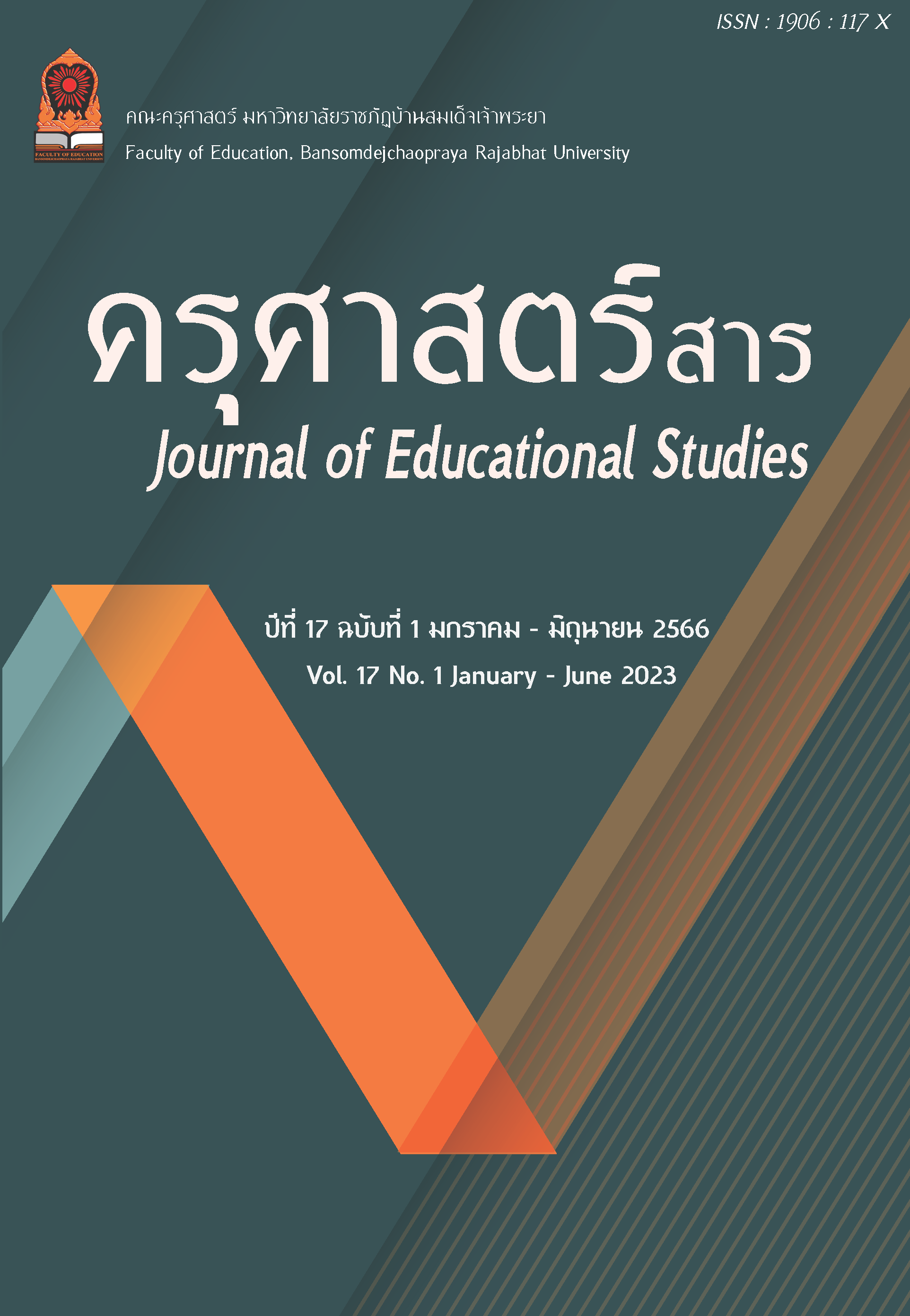Guidelines for Promoting Desirable Characteristics of Vocational Students in The Digital age: Cross–Impact Analysis
Keywords:
cross–impact analysis, desirable characteristics in the digital age, Vocational Students in the digital ageAbstract
The purpose of research was 1) to analyze desirable characteristics of vocational students in the digital age; and 2) to present guidelines for promoting desirable characteristics of vocational students in the digital age. For research sources, three sources were used: documents and articles in Thailand and other countries, job description and interview the needs of entrepreneurs derived from the application of crowdsourcing and text mining. The data were analyzed with co-occurrence by the R Program and evaluated the feasibility of a guidelines with cross–impact analysis by 5 experts.
The research findings were as follows:
1. The top ten common desirable characteristics of vocational students in the digital age that the labor market wanted were: patient, responsibility, interpersonal skills, diligence, basic programming skills, honesty, service minded, studiousness, tools and equipment skills and teamwork skills.
2. Guidelines for promoting desirable characteristics of vocational students in the digital age were as follows: 1) The policy department had no guidelines for promoting that affected other guidelines. 2).The graduate production department had two guidelines that affected other guidelines: (2.1) Teachers managed teaching and learning to better fit the context of working.in the digital age and (2.2) Directors of educational institutions developed extra-curricular activities on future skills. 3)The employer department had three guidelines that affected other guidelines: (3.1) Entrepreneurs organized student workshops before work and held student’s meetings at least once a month for students in order to assess themselves. (3.2) Entrepreneurs enhanced the use of Information technology with modern and adequate equipment; and (3.3) Entrepreneurs attached great importance to developing coaching skills to student’s advisors.
Downloads
References
กระทรวงศึกษาธิการ. (2562). หลักสูตรประกาศนียบัตรวิชาชีพ พุทธศักราช 2562. สืบค้นจาก http://bsq.vec.go.th/Portals/9/Course/20/2562/newv1.pdf
กระทรวงศึกษาธิการ. (2563). หลักสูตรประกาศนียบัตรวิชาชีพชั้นสูง พุทธศักราช 2563. สืบค้นจาก http://bsq.vec.go.th/Portals/9/Course/30/2563/Commandv1.pdf
เกียรติ แดงสีดา, พิมผกา ธรรมสิทธิ์ และวจี ปัญญาใส. (2563).ยุคดิจิทัลกับแนวทางการบริหารแหล่งเรียนรู้ในสถานศึกษาสังกัดสำนักงานเขตพื้นที่การศึกษาประถมศึกษาพิษณุโลก เขต 1. วารสารมหาจุฬานาครทรรศน์,7(6). 45-59.
ณัฐสิฏ รักษ์เกียรติวงศ์..(2560)..การปฏิรูปอาชีวศึกษาของประเทศไทย. สืบค้นจาก https://tdri.or.th/ wp-content/uploads/2016/08/nuthasid-vocational-education-v02_2.pdf
Abdurakhmanova, G., Shayusupova, N., Irmatova, A., & Rustamov, D. (2020). The role of the digital economy in the development of the human capital market. International Journal of Psychological Rehabilitation, 24(7), 8043-8051.
Auld, E., & Morris, P. (2019). The OECD and IELS: Redefining early childhood education for the 21st century. Policy Futures in Education, 17(1), 11-26.
Choi, D. S., Sung, C. S., & Park, J. Y. (2020). How does technology startups increase innovative performance? The study of technology startups on innovation focusing on employment change in Korea. Sustainability, 12(2), 551.
Fareri, S., Fantoni, G., Chiarello, F., Coli, E., & Binda, A. (2020). Estimating Industry 4.0 impact on job profiles and skills using text mining. Computers in industry, 118, 103222.
Gaikwad, S. V., Chaugule, A., & Patil, P. (2014). Text mining methods and techniques. International Journal of Computer Applications, 85(17).
Gordon, T. J. (1994). Cross-impact method. American Council for the United Nations
University. Habtoor, N., & Alharbi, A. A. (2020). Importance of Human Factors to Organizational Performance. International Journal of Management and Human Science (IJMHS), 4(1), 11-22.
He, Z. (2021). Cross Platform Text Mining Based on Public Emergency—Using Word2 vec Model and K-means Algorithm. In 2021 IEEE International Conference on Artificial Intelligence and Computer Applications (ICAICA), (1-7).
Kantardzic, M. (2011). Data mining: concepts, models, methods, and algorithms. John Wiley & Sons.
Karachiwalla, R., & Pinkow, F. (2021). Understanding crowdsourcing projects: A reviewon the key design elements of a crowdsourcing initiative. Creativity and Innovation Management.
Lim, J. E., Lee, J., & Kim, D. (2021). The effects of feedback and goal on the quality of crowdsourcing tasks. International Journal of Human–Computer Interaction, 1-13.
Lodi, E., Zammitti, A., Magnano, P., Patrizi, P. & Santisi, G. (2020). Italian Adaption of Self-Perceived Employability Scale: Psychometric Properties and Relations with the Career Adaptability and Well-Being. Behavioral Science, 10, 1-18 https:// doi:10.3390/ bs10050082.
Sauli, F. (2021). The collaboration between Swiss initial vocational education and training partners: perceptions of apprentices, teachers, and in-company trainers. Empirical Research in Vocational Education and Training, 13(1), 1-22.
Thoben, K.-D., Wiesner, S.A., Wuest, T., (2017). Industrie 4.0 and smart manufacturing a review of research issues and application examples. Int. J. Autom. Technol. 11(1).
Xie, X., Fu, Y., Jin, H., Zhao, Y., & Cao, W. (2020). A novel text mining approach for Scholar information extraction from web content in Chinese. Future Generation Computer Systems, 111, 859-872.
Zhang, A. (2012). Peer assessment of soft skills and hard skills. Journal of Information Technology Education: Research, 11(1), 155-168.
Downloads
Published
How to Cite
Issue
Section
License

This work is licensed under a Creative Commons Attribution-NonCommercial-NoDerivatives 4.0 International License.
บทความที่ได้รับการตีพิมพ์เป็นลิขสิทธิ์ของคณะครุศาสตร์ มหาวิทยาลัยราชภัฏบ้านสมเด็จเจ้าพระยา
ข้อความที่ปรากฏในบทความแต่ละเรื่องในวารสารวิชาการเล่มนี้เป็นความคิดเห็นส่วนตัวของผู้เขียนแต่ละท่านไม่เกี่ยวข้องกับมหาวิทยาลัยราชภัฏบ้านสมเด็จเจ้าพระยา และคณาจารย์ท่านอื่นๆในมหาวิทยาลัยฯ แต่อย่างใด ความรับผิดชอบองค์ประกอบทั้งหมดของบทความแต่ละเรื่องเป็นของผู้เขียนแต่ละท่าน หากมีความผิดพลาดใดๆ ผู้เขียนแต่ละท่านจะรับผิดชอบบทความของตนเอง



